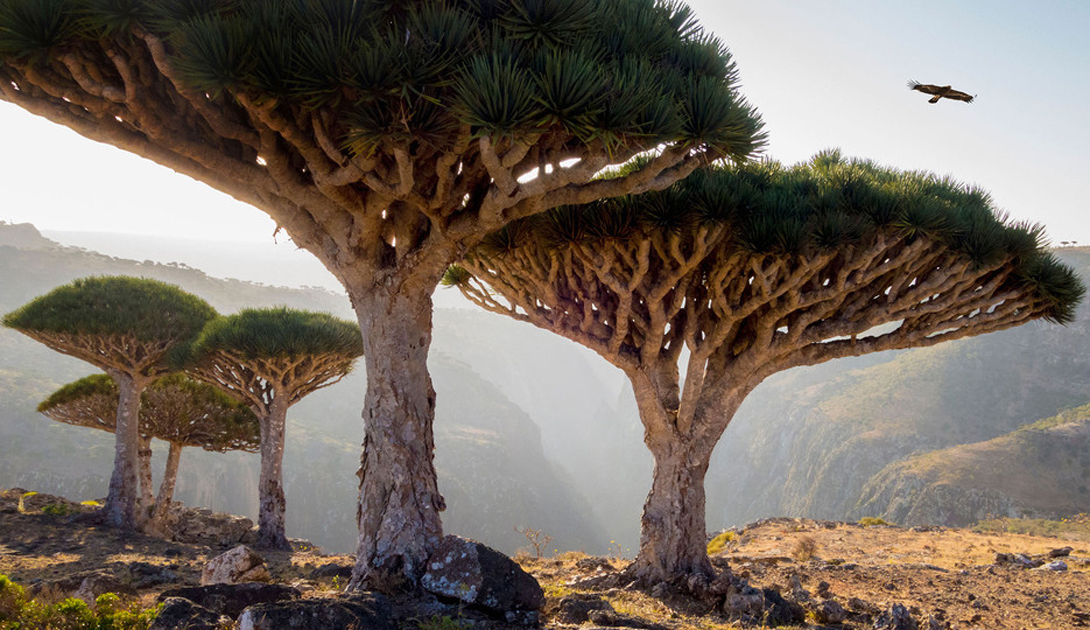Imagine an island so remote and untouched that it feels like stepping into another world. Socotra, often dubbed the "Galápagos of the Indian Ocean," is a surreal destination that beckons adventurous travelers with its otherworldly landscapes, rare endemic species, and pristine beaches. Located approximately 400 km off the coast of Yemen, this UNESCO-listed island is a treasure trove of natural wonders and unique cultural heritage.
For travelers seeking exotic beauty, isolation, and a deep connection with nature, Socotra offers an experience like no other. From its bizarre Dragon’s Blood Trees to its turquoise lagoons and massive sand dunes, this is one of the world’s last truly unexplored paradises.
The Unique Landscapes of Socotra
The Iconic Dragon’s Blood Trees: Nature’s Umbrellas

One of Socotra’s most recognizable and surreal features is the Dragon’s Blood Tree (Dracaena cinnabari), which boasts a distinctive umbrella-like canopy and blood-red sap. Found mostly in the Dixam Plateau, these trees are thought to be over 1,000 years old and have been used for centuries for their medicinal properties. Walking through a forest of these trees feels like stepping onto an alien planet.
Dixam Plateau & Wadi Dirhur Canyon: A Hiker’s Dream

Dixam Plateau is one of the best places to witness Socotra’s geological beauty. This highland region provides breathtaking views of deep canyons, rugged rock formations, and rare plant species. Wadi Dirhur Canyon, a hidden gem within this plateau, is a perfect spot for trekking, featuring emerald pools and dramatic cliffs.
Pristine Beaches: Where the Desert Meets the Sea
Socotra’s coastline is a masterpiece of turquoise waters, powdery white sands, and rolling dunes. Some of the best beaches include:
- Qalansiyah Beach & Detwah Lagoon: Known for its crystal-clear waters, this spot is perfect for snorkeling and birdwatching.
- Arher Beach: Famous for its towering sand dunes that reach over 100 meters, offering an incredible view of the coastline.
- Shoab Beach: Only accessible by boat, this remote beach is a paradise for solitude seekers and nature lovers.
Socotra’s Fascinating Biodiversity

Socotra’s isolation has allowed for the evolution of unique species, with over 700 plant species, 90% of its reptiles, and nearly 40% of its plant life found nowhere else on Earth.
Flora: The Weird and the Wonderful
- Desert Rose (Adenium obesum socotranum): A bulbous, tree-like plant with vibrant pink flowers, often called the "Elephant Foot Tree."
- Cucumber Tree (Dendrosicyos socotranus): A rare species that looks like an oversized cucumber growing on a tree.
- Frankincense Trees: Used since ancient times for their aromatic resin, which was once more valuable than gold.
Fauna: A Haven for Birdwatchers and Divers
- Socotra Sunbird & Socotra Starling: Two of the most iconic endemic bird species found on the island.
- Marine Life: With untouched coral reefs, Socotra offers some of the best diving and snorkeling opportunities in the region, home to dolphins, sea turtles, and vibrant fish species.
The Cultural Charm of Socotra

Socotra’s indigenous people, the Socotris, have a unique culture influenced by African, Arab, and Indian traditions.
The Socotri Language & Traditions
The Socotri language, an ancient Semitic dialect, has been passed down orally for generations. Traditional crafts such as weaving, pottery, and boat-making are still practiced today.
Local Villages & Nomadic Life
Most Socotris live a semi-nomadic lifestyle, herding goats and fishing for sustenance. Visitors can stay in traditional Socotri villages, experiencing firsthand the warmth and hospitality of the locals.
Essential Travel Information for Visiting Socotra
How to Get There
Flights to Socotra are limited and seasonal, typically operating from Cairo (Egypt) or Abu Dhabi (UAE). Booking in advance is essential, as there are no direct commercial flights from Western countries.
Visa & Entry Requirements
- A special Yemen visa is required to enter Socotra.
- Travel permits are usually arranged through local tour operators, making it easier for visitors.
Best Time to Visit
The best time to visit Socotra is between October and April, when the weather is mild and the island is lush. Avoid the monsoon season (May to September), as strong winds and high tides make travel difficult.
Must-Try Activities in Socotra
For adventure lovers, Socotra offers plenty of outdoor activities:
- Trekking & Hiking: Dixam Plateau and Hoq Cave are perfect for hiking enthusiasts.
- Snorkeling & Diving: The untouched coral reefs are teeming with marine life.
- Camping Under the Stars: There are no large hotels on the island, so camping along the beaches or in the mountains is an unforgettable experience.
Travel Tips for an Unforgettable Trip
- Go with a Local Guide: Travel infrastructure is limited, and guides provide valuable knowledge about the island’s ecology and culture.
- Pack Light but Smart: Essentials include sunscreen, insect repellent, a power bank, and sturdy hiking shoes.
- Respect the Environment: Socotra is an eco-sensitive zone, so visitors should practice responsible tourism.
Why Socotra Should Be on Your Travel Bucket List
Socotra is not just a destination; it’s an adventure into the unknown. Whether you’re drawn to its dramatic landscapes, rare wildlife, or rich cultural heritage, visiting this remote paradise is an experience unlike any other.
If you’re a traveler who craves untouched beauty, off-the-beaten-path destinations, and a true sense of discovery, then Socotra should be at the top of your bucket list.




